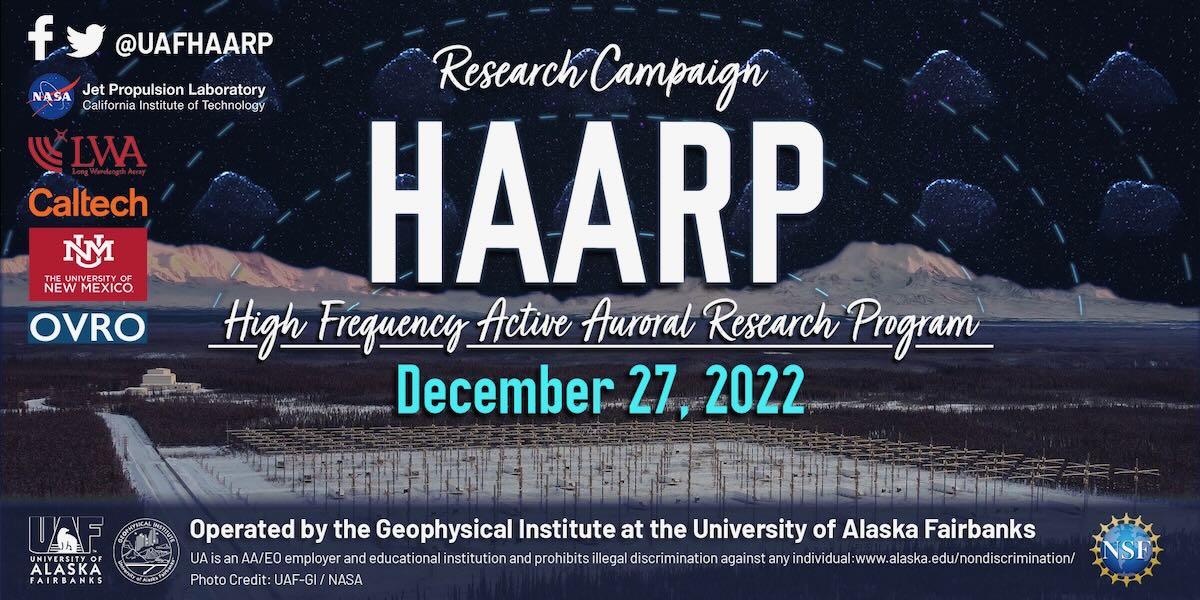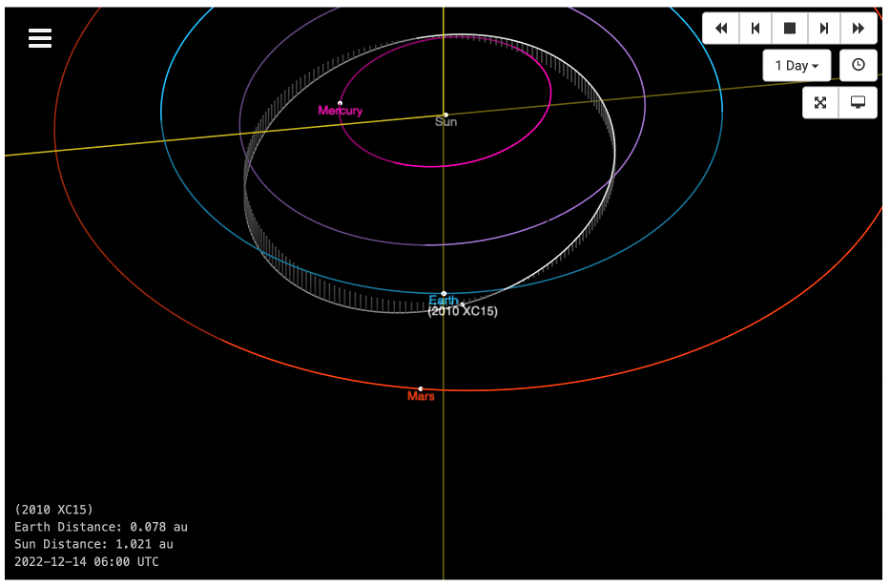 Many thanks to a number of SWLing Post readers who share the following announcement–also previously noted by Robert–from the University of Alaska Fairbanks (followed by an announcement from the ARRL):
Many thanks to a number of SWLing Post readers who share the following announcement–also previously noted by Robert–from the University of Alaska Fairbanks (followed by an announcement from the ARRL):
HAARP to bounce signal off asteroid in NASA experiment (UAF News)
An experiment to bounce a radio signal off an asteroid on Dec. 27 will serve as a test for probing a larger asteroid that in 2029 will pass closer to Earth than the many geostationary satellites that orbit our planet.
The High-frequency Active Auroral Research Program research site in Gakona will transmit radio signals to asteroid 2010 XC15, which could be about 500 feet across. The University of New Mexico Long Wavelength Array near Socorro, New Mexico, and the Owens Valley Radio Observatory Long Wavelength Array near Bishop, California, will receive the signal.
This will be the first use of HAARP to probe an asteroid.
“What’s new and what we are trying to do is probe asteroid interiors with long wavelength radars and radio telescopes from the ground,” said Mark Haynes, lead investigator on the project and a radar systems engineer at NASA’s Jet Propulsion Laboratory in Southern California. “Longer wavelengths can penetrate the interior of an object much better than the radio wavelengths used for communication.”
Knowing more about an asteroid’s interior, especially of an asteroid large enough to cause major damage on Earth, is important for determining how to defend against it.
“If you know the distribution of mass, you can make an impactor more effective, because you’ll know where to hit the asteroid a little better,” Haynes said.
Many programs exist to quickly detect asteroids, determine their orbit and shape and image their surface, either with optical telescopes or the planetary radar of the Deep Space Network, NASA’s network of large and highly sensitive radio antennas in California, Spain and Australia.
Those radar-imaging programs use signals of short wavelengths, which bounce off the surface and provide high-quality external images but don’t penetrate an object.
HAARP will transmit a continually chirping signal to asteroid 2010 XC15 at slightly above and below 9.6 megahertz (9.6 million times per second). The chirp will repeat at two-second intervals. Distance will be a challenge, Haynes said, because the asteroid will be twice as far from Earth as the moon is. [Continue reading…]
The ARRL provides the following specific information about how SWLs and Hams can participate:
Amateur Radio Operators Invited to participate in Asteroid Bounce Experiment (ARRL News)
The High-frequency Active Auroral Research Program (HAARP) will be conducting a research campaign/experiment on December 27, 2022, with transmissions between 1100 – 2300 UTC (0200 – 1400 AKST).
[…]Actual transmit times are highly variable based on real-time ionospheric conditions and all information is subject to change. Currently, the Asteroid Bounce (2010 XC15) experiment will take place Dec. 27, 2022, from 1100 UTC to 2300 UTC; 9.6 MHz, LFM (linear FM), 0.5 Hz WRF (waveform repetition frequency), 30 kHz bandwidth. Reports recording echo are encouraged; demodulated recordings in .wav or .mp3 are recommended.
For real-time ionospheric conditions in Gakona, please consult ionograms from the HAARP Diagnostic Suite at https://haarp.gi.alaska.edu/diagnostic-suite.
Amateur radio and radio astronomy enthusiasts are invited to listen to the transmissions/echoes and submit reception reports to the HAARP facility at [email protected] and request a QSL card by mailing a report to:
HAARP
P.O. Box 271
Gakona AK 99586
USA
Click here to read this announcement on the ARRL News website.


People are not likely hearing the echo from the asteroid, which would be extremely weak. They are probably hearing the outgoing signal from HAARP as reflected by the ionosphere.
I tuned in at 21:45 this afternoon from Emigrant, Montana USA on UTC date December 27, 2022.
I was using an SDR. The waterfall looked like a series of forward slashes in a column. The sound was like a low-frequency beat, 5 or so in the space of one second. Then an equal amount of time with no beats. It was pretty cool listening to a signal coming from an asteroid. I emailed a reception report that included a wav file and a waterfall display. Hopefully, this will help them in their research. I hope I get an eQSL. I only have one in my online QSL catalog, the Outer Space section. That is from the ISS.
Link to my QSL catalog – https://www.timslife.com/QSL/dx00.php
I could hear it here around 1845 UT in San Diego as a CODAR-type sweeping signal. I would think that the return from the Asteroid would be delayed by the distance as well as with doppler shift from the speed of the asteroid. Nothing of that sort heard in the background by my local noise level is very high!
On websdr, goto the Twenty NL SDR, tune to 9585 khz USB, hit the Wider button until you get 6.76 khz width. hit the record button.
That could be it. Two seconds between chirps? On the waterfall, looks like a sequence of dashed lines. But are we seeing a reflection from the asteroid or the ionosphere? Maybe the strong outgoing signal can pierce through the ionosphere at any frequency but the ionospheric conditions would have to be such that the MUF is below 9600 kHz for the weak return signal to arrive at the receiver, I presume.
Tune to 9586 USB set the Twenty SDR to 6.77khz wider (keep hitting the wider button). Clearly heard now.
Yup, a faint, elongated, wispy chirp every two seconds exactly according to the audio file in Audacity.
For those not able to tune in, here are a couple videos I made of the signal between 1730 and 1800 UTC in Southern Idaho. If these aren’t allowed, by apologies:
Part 1: https://youtu.be/nzVOY8Mvpuc
Part 2 (louder and stronger): https://youtu.be/G08vffP2Ipg
My SDR has modes “NFM” and “WFM”. What is “Linear FM” as stated in the article????
When you are in USB mode, what does the waveform look like on the waterfall?? I am not sure what I am supposed to look for and the ARRL instructions do not make that clear.
If you e-mail me at [email protected], I will send you a screenshot of the U. Twente SDR receiver waterfall.
On the Twenty websdr site, I heard a faint chirping just before 1800 UTC while in USB mode. It only lasted maybe about 10 – 15 seconds. The waterfall looked like a few horizontal lines as each chirp sounded.
Good reception of the echoes heard beginning around 12:25 UT. Demodulated in USB with 3.5 kHz bandwidth. Spectrum scope on Icom R8600 displayed the echoes sweeping over the 30 kHz bandwidth. Audio chirps at the specified 2-sec interval. Location is southeastern Arizona USA
Using the U. Twente SDR receiver again, the signal is now in the clear at 15:40 UTC. Best heard in USB. Signal can also be clearly seen on the waterfall.
Hi Folks ..!
Can you include, as Richard Langley has done, the time in UTC when you post your comments.
Though a time of posting is shown, the time zone is not. I am guessing it’s ET (USoA) because am & pm are shown.
The reason I write this comment is (1) because the HAARP experiment is of worldwide interest and (2) reception reports are requested. BTW the QSL, if you want one, will no doubt use UTC.
73 de G8AUU es SO6AUU/9
My last was posted at 13h18 UTC
Would am narrow or cw mode be better than am wide?
Right now — 1152Z — I have an Icom 706 tuned to 9600 in FM mode with the noise squelched out.
What would I expect to hear if the signal breaks the squelch?
Cheers, Jock
Can be heard right now (12:26 UTC) using the U. Twente SDR receiver. Best in USB mode as there is co-channel QRM from China Radio International at the moment.
All I am hearing is noise and occasionally a faint whine in the background.
I guess you would hear some kind of sweeps within +/- 15kHz, I can hear something like that on the Twente SDR and in Ireland but given the currently stormy condx I’m thinking it’s rather unlikely to come via the pole from Gakona. If it does anyway, that kind of modulation isn’t ideal for detecting and identifying the Doppler-shifted echoes using only the extremely faint signals by ear and most Kiwis are just too insensitive and noise-ridden to give useful waterfall plots and probably lack the resolution. Guessing more, to actually hear the echoes a nearby receiver that’s within the dead zone of the Gakona transmitter (if it actually has one, beaming straight up) would be ideal.
Forgot to mention that the signal is technically FM does not mean you can use FM mode to hear it, USB is probably more likely to give you an audible result.
(I wish I could edit my comments) The bandwidth of the sweeps would indicate that it actually is the signal from Gakona sweeping across all the radio stations on the Twente SDR. Strange that I can’t find one KiwiSDR in the US picking that up.
It was well heard in WA, and certainly very strong into Masset, BC. The problem with KiwiSDRs is there’s a lot of crappy receivers out their, so one really has to search for a decent one. I was able to confirm HAARP from Iceland, Scandinavia and eastern Siberia without any issues.